Surface Plasmon Resonance Sensor Based on Polymer Photonic Crystal Fibers with Metal Nanolayers
Abstract
:1. Introduction
2. Numerical Simulation and Analysis
2.1. PMMA Photonic Crystal Fiber-Based of 250 μm Diameter SPR Sensor
2.2. PMMA Photonic Crystal Fiber-Based of 125 μm Diameter SPR Sensor (Seven Air Holes)
2.3. Introduction of More Air Holes into the PMMA Photonic Crystal Fiber-Based of 125 μm Diameter SPR Sensor
2.4. Optimizations of Structural Parameters
3. Conclusions
Acknowledgments
References
- Zheng, R.S.; Lu, Y.H.; Xie, Z.G.; Tao, J.; Lin, K.Q.; Ming, H. Surface plasmon resonance sensors based on polymer optical fiber. J. Elec. Sci. China 2008, 6, 357–360. [Google Scholar]
- Alireza, H.; Bertrand, G.; Majid Fassi, F.; Andrei, K.; Maksim, S. Photonic crystal fiber and waveguide-based surface plasmon resonance sensors for application in the visible and near-ir. Electromagnetics 2008, 25, 198–213. [Google Scholar]
- Homola, J.; Yee, S.; Gauglitz, G. Surface plasmon resonance sensors: Review. Sens. Actuators B: Chem. 1999, 54, 3–15. [Google Scholar]
- Barnes, W.L.; Dereux, A.; Ebbesen, T.W. Surface plasmon subwavelength optics. Nature 2003, 424, 824–830. [Google Scholar]
- Gupta, B.D.; Verma, R.K. Surface plasmon resonance-based fiber optic sensors: Principle, probe designs, and some applications. J. Sens. 2009. [Google Scholar] [CrossRef]
- Fu, X.Y.; Lu, Y.; Huang, X.H.; Yao, J.Q. Surface plasmon resonance sensor based on photonic crystal fiber filled with silver nanowires. Opt. Appl. 2011, 41, 941–951. [Google Scholar]
- Hassani, A.; Skorobogatiy, M. Design criteria for microstructured-optical fiber-based surface-plasmon-resonance sensors. J. Opt. Soc. Am. B 2007, 24, 1423–1429. [Google Scholar]
- Yu, X.; Zhang, Y.; Pan, S.S.; Shu, P.; Yan, M.; Leviatan, Y.; Li, C.M. A selectively coated photonic crystal fiber based surface plasmon resonance sensors. J. Opt. 2010, 12, 1–4. [Google Scholar]
- Zhang, Y.; Xia, L.; Zhou, C.; Yu, X.; Liu, H.; Liu, D.; Zhang, Y. Microstructured fiber based plasmonic index sensor with optimized accuracy and calibration relation in large dynamic range. Opt. Commun. 2011, 284, 4161–4166. [Google Scholar]
- Hautakorpi, M.; Mattinen, M.; Ludvigsen, H. Surface-plasmon-resonance sensor based on three-hole microstructured optical fiber. Opt. Express 2008, 16, 8427–8432. [Google Scholar]
- Alireza, H.; Maksim, S. Photonic crystal fiber-based plasmonic sensors for the detection of biolayer thickness. JOSA B 2009, 26, 1550–1557. [Google Scholar]
- Hassani, A.; Skorobogatiy, M. Design of the microstructured optical fiber-based surface plasmon resonance sensors with enhanced micro fluidics. Opt. Express 2006, 14, 11616–11621. [Google Scholar]
- Jerzy, K.; Michal, B.; Maria, B. Plastic optical fibers in sensors—A review. Proc. SPIE 2004, 5576, 234–238. [Google Scholar]
- Jensen, J.B.; Hoiby, P.E.; Emiliyanov, G.; Bang, O.; Pedersen, L.; Bjarklev, A. Selective detection of antibodies in microstructured polymer optical fibers. Opt. Express 2005, 13, 5883–5889. [Google Scholar]
- Large, M.; Poladian, L.; Barton, G.; van Eijkelenborg, M.A. Microstructured Polymer Optical Fibres; Springer: Sydney, Australia, 2008; Chapter 7; pp. 213–227. [Google Scholar]
- Ziemann, O.; Krauser, J.; Zamzow, P.E.; Daum, W. POF Handbook; Springer: Berlin, Germany, 2008. [Google Scholar]
- Wang, A.; Docherty, A.; Kuhlmey, B.T.; Felicity, M.C.; Maryanne, C.J.L. Side-hole fiber sensor based on surface plasmon resonance. Opt. Lett. 2009, 34, 3890–3892. [Google Scholar]
- Lu, Y.; Wu, B.; Fu, X.; Hao, C.; Huang, X.; Yao, J. Microstructured polymer optical fiber-based surface plasmon resonance sensors. Proc. SPIE 2012. [Google Scholar] [CrossRef]
- Wang, Y.; Xue, J.; Lan, X.; Zhang, J. The progress of the research on polymer photonic crystal fiber. Proceedings of OFCIO'2003, Beijing, China, 8 October 2003; pp. 517–522.
- Christos, M.; Wu, Y.; Kyriakos, V.; Graham, E.T.; Ole, B. Label-free biosensing with high sensitivity in dual-core microstructured polymer optical fibers. Opt. Exp. 2011, 19, 7790–7798. [Google Scholar]
- Kasarova, S.N.; Sultanova, N.G.; Ivanov, C.D.; Nikolov, I.D. Analysis of the dispersion of optical plastic materials. Opt. Mater. 2007, 29, 1481–1490. [Google Scholar]
- Edward, D.P. Handbook of Optical Constants of Solids; Academic Press: Boston, MA, USA, 1985. [Google Scholar]
- Gauvreau, B.; Hassani, A.; Fehri, M.F.; Kabashin, A.; Skorobogatiy, M.A. Photonic bandgap fiber-based surface plasmon resonance sensors. Opt. Exp. 2007, 15, 11413–11426. [Google Scholar]

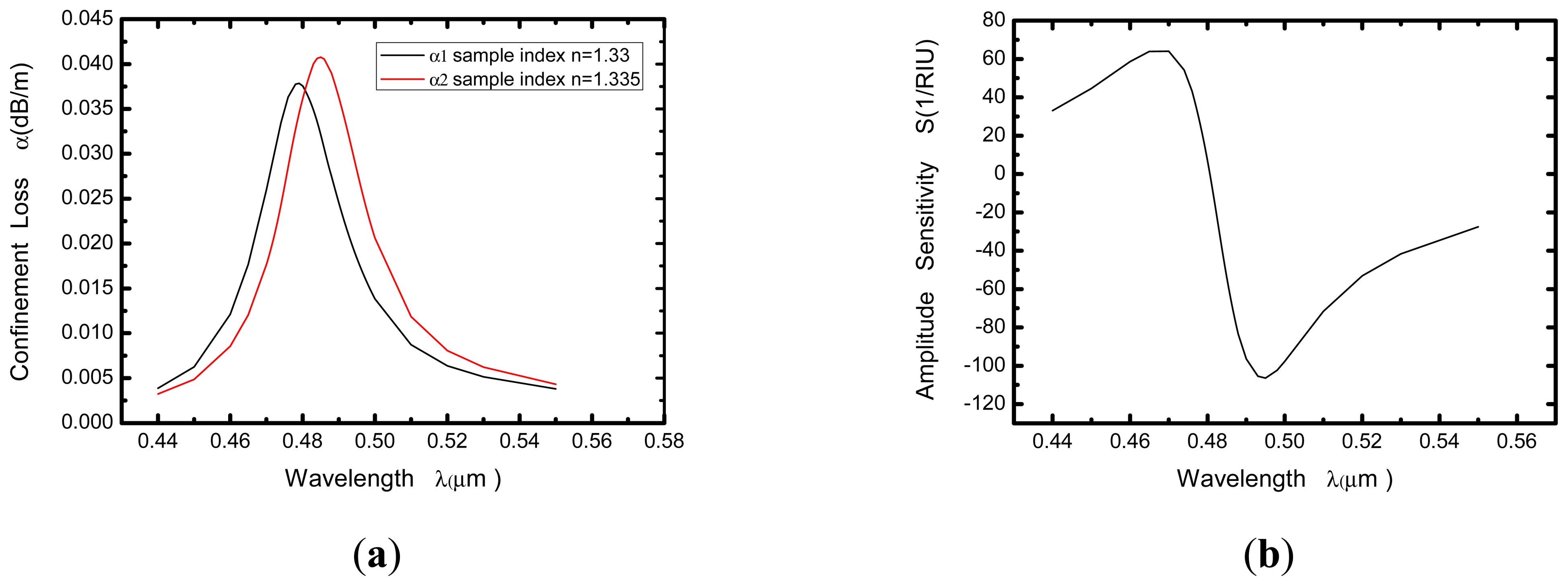
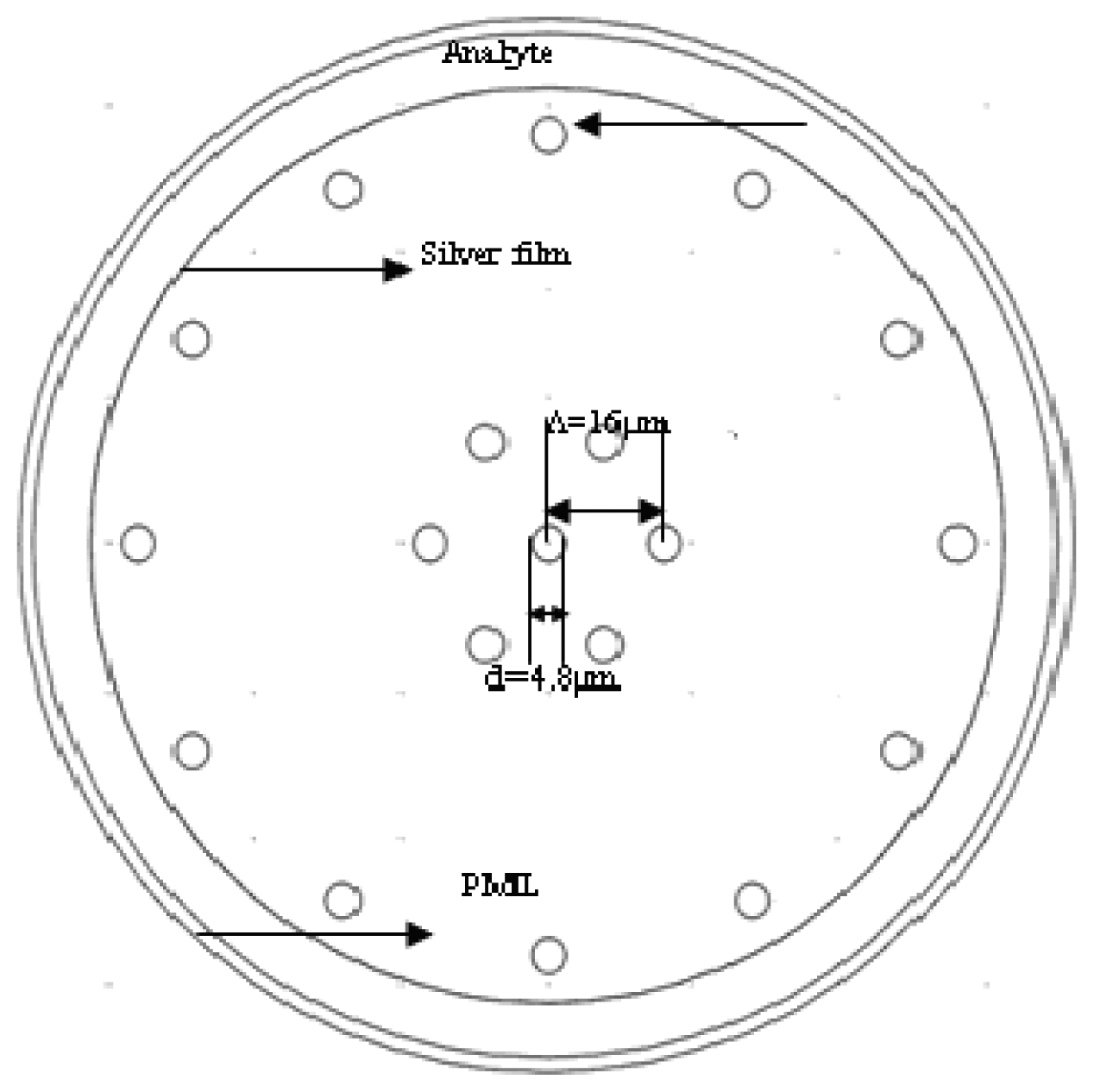
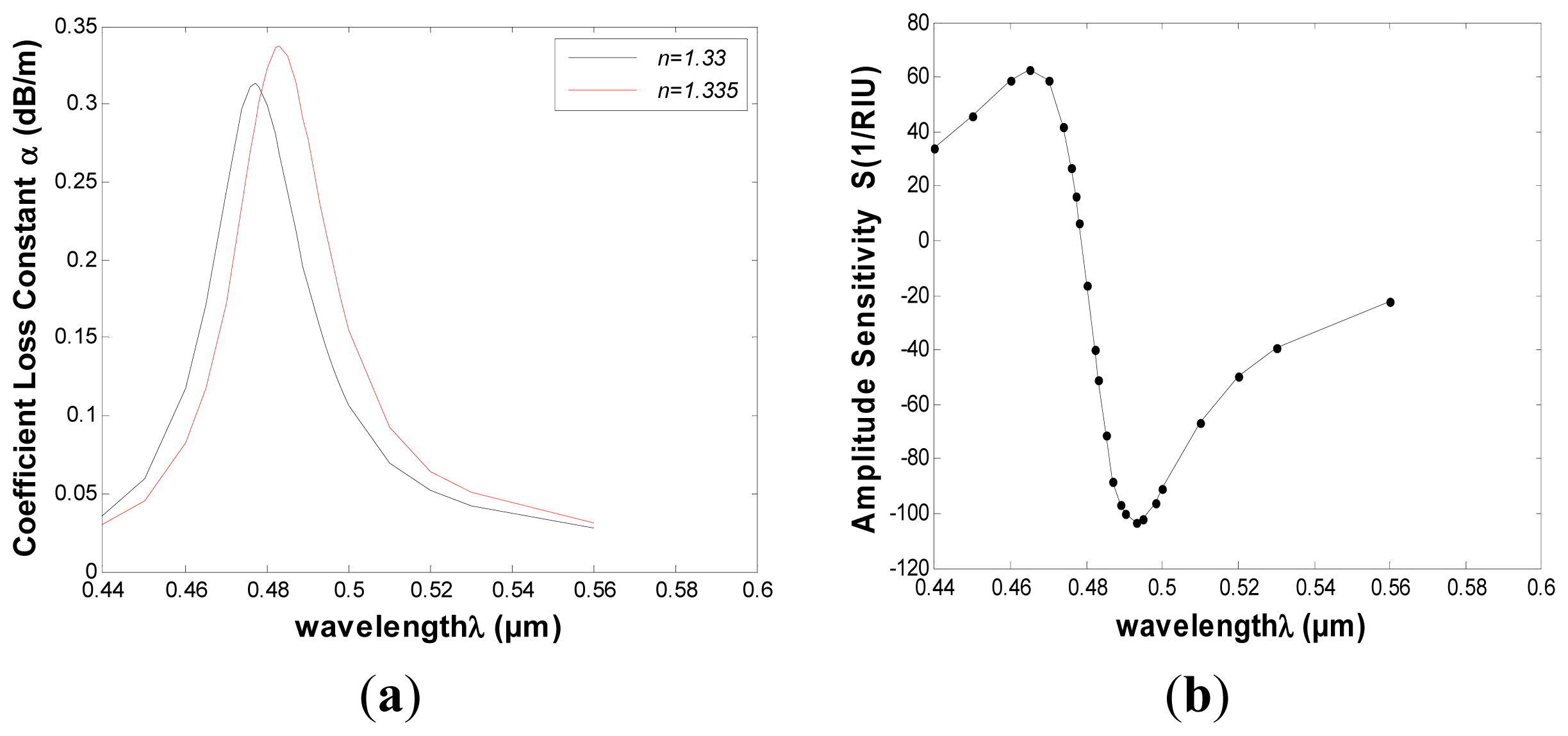
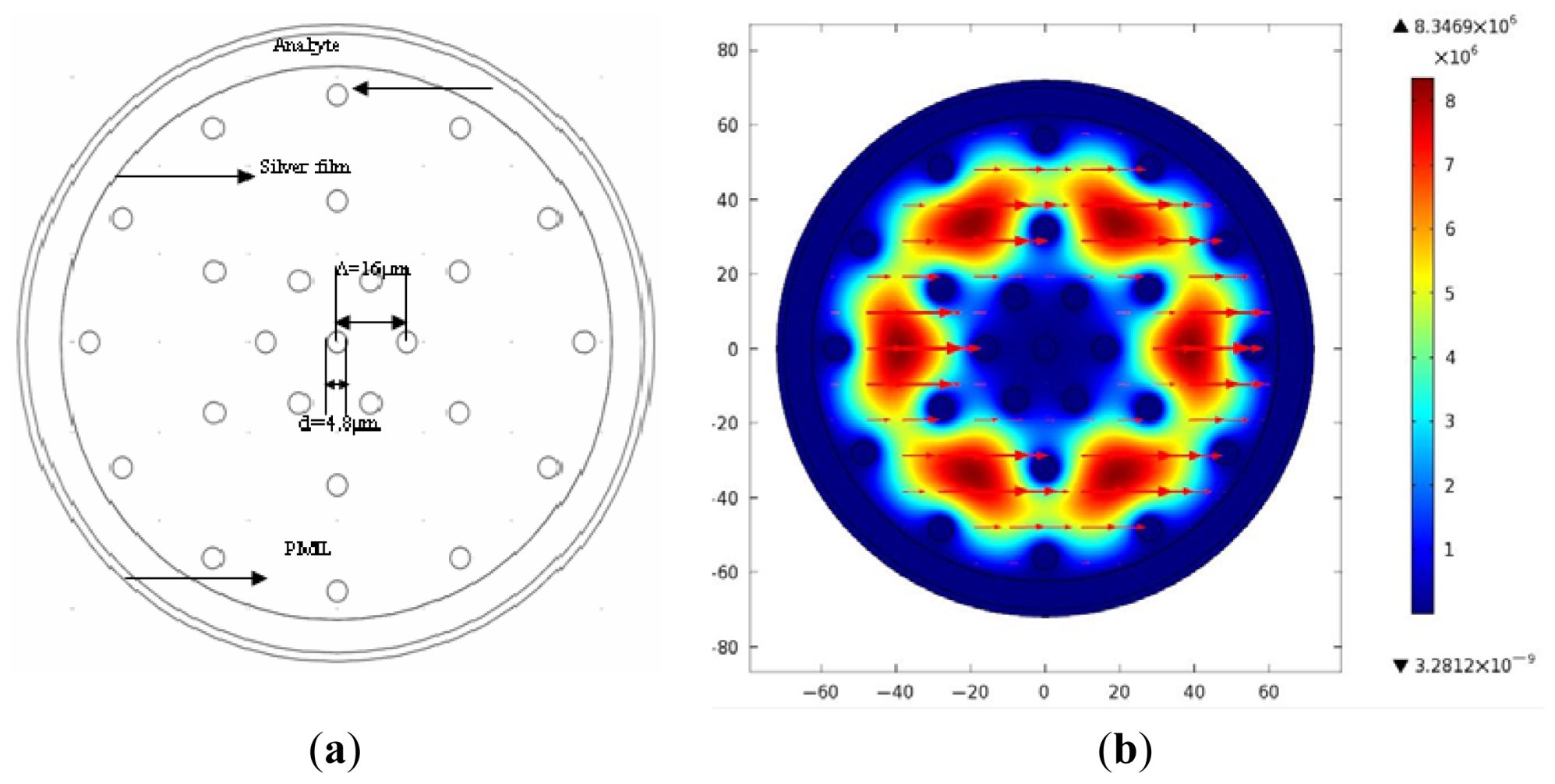
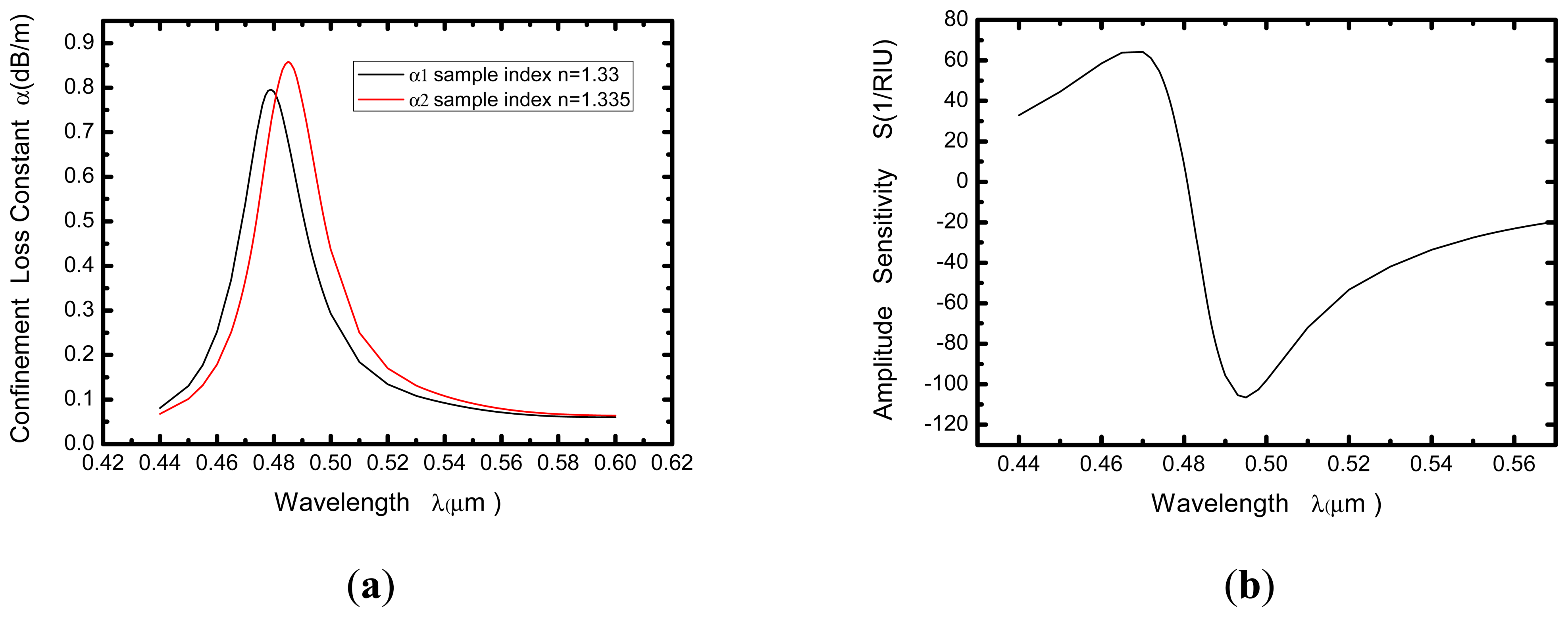
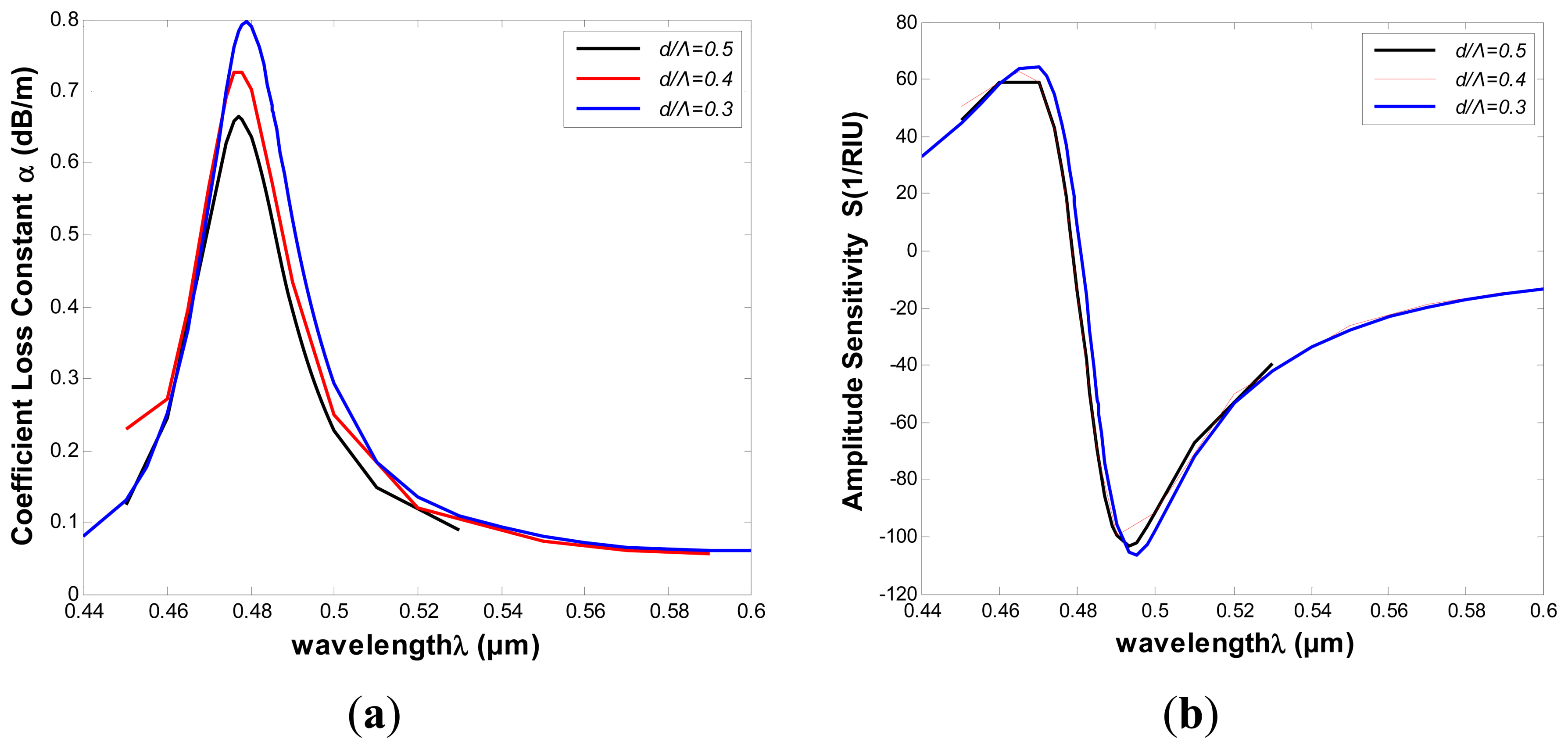
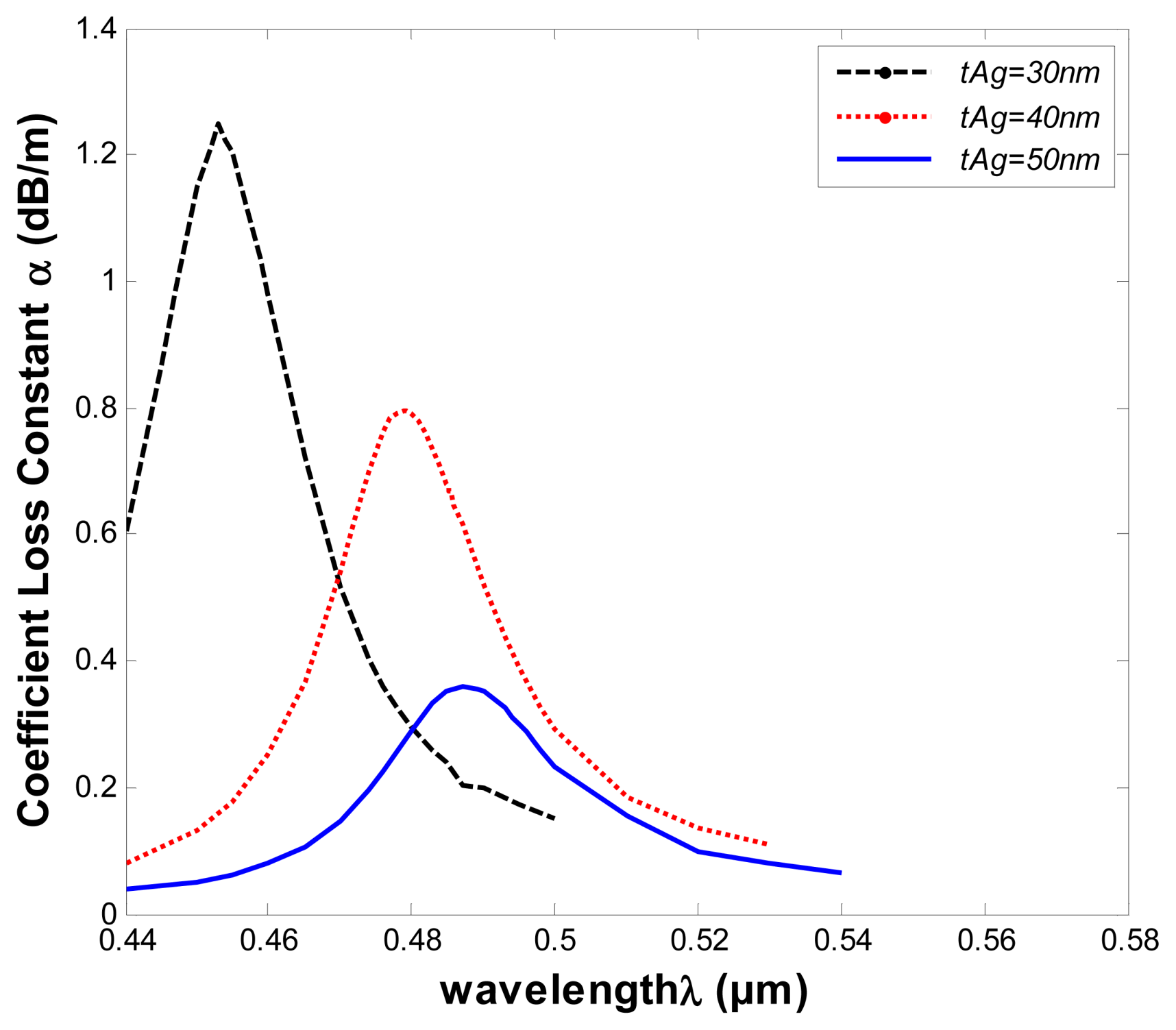
© 2013 by the authors; licensee MDPI, Basel, Switzerland. This article is an open access article distributed under the terms and conditions of the Creative Commons Attribution license (http://creativecommons.org/licenses/by/3.0/).
Share and Cite
Lu, Y.; Hao, C.-J.; Wu, B.-Q.; Musideke, M.; Duan, L.-C.; Wen, W.-Q.; Yao, J.-Q. Surface Plasmon Resonance Sensor Based on Polymer Photonic Crystal Fibers with Metal Nanolayers. Sensors 2013, 13, 956-965. https://doi.org/10.3390/s130100956
Lu Y, Hao C-J, Wu B-Q, Musideke M, Duan L-C, Wen W-Q, Yao J-Q. Surface Plasmon Resonance Sensor Based on Polymer Photonic Crystal Fibers with Metal Nanolayers. Sensors. 2013; 13(1):956-965. https://doi.org/10.3390/s130100956
Chicago/Turabian StyleLu, Ying, Cong-Jing Hao, Bao-Qun Wu, Mayilamu Musideke, Liang-Cheng Duan, Wu-Qi Wen, and Jian-Quan Yao. 2013. "Surface Plasmon Resonance Sensor Based on Polymer Photonic Crystal Fibers with Metal Nanolayers" Sensors 13, no. 1: 956-965. https://doi.org/10.3390/s130100956



